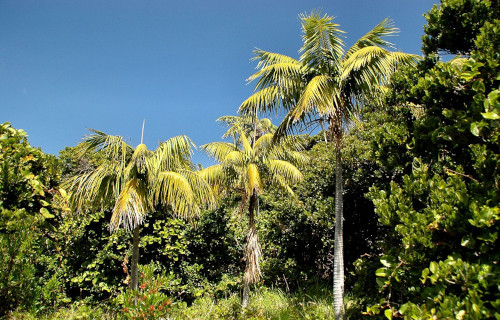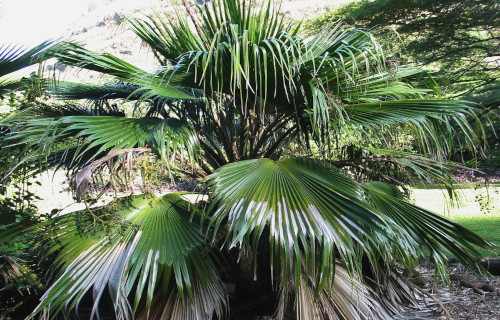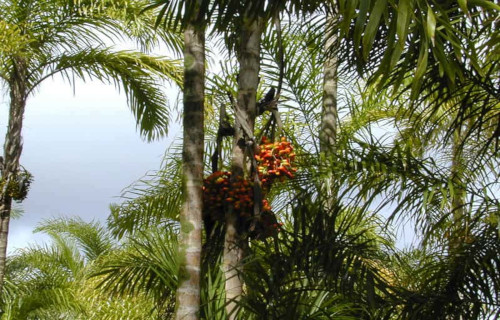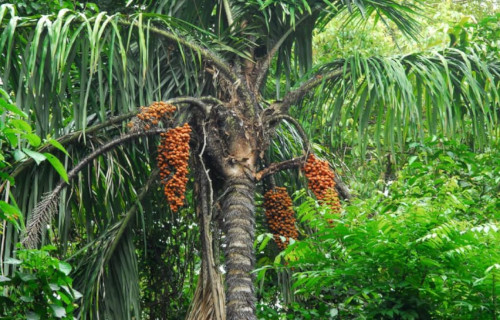We greatly hope that each of you, our readers, will completely enjoy and appreciate this article about these 4 Perfectly Pleasing Palms. It was certainly a great pleasure for us to compile the information for you. May it both educate and enlighten you about such marvels.
Of course, the few species listed here represent on a small portion of the botanical marvels contained with this Family. We sincerely feel, however, that these represent good examples of the variety found among these trees. You’ll also find similar species in our other articles.
Canary Island Date Palm
Canary Island Date Palm Facts
- Leading off this article about these 4 Perfectly Pleasing Palms we present the marvelous tree known as the Canary Island Date Palm.
- This product of evolution and Nature most frequently goes by the informative common name it does for excellent reasons. It also has another general name, though. That’s because it’s also known by the shorter term of the pineapple palm.
- Among professionals, such as researchers, however, it’s generally better known by its official title. That moniker, though, as often occurs, is somewhat hard for the layperson to pronounce. That’s due to it having the formal name of Phoenix canariensis.
- The tree received that name due to the work of the respected French botanist, Jutin-Benjamin Chabaud. He made the first formal acknowledgement of it as a separate and distinct species. This noteworthy action occurred in the late 19th century.
- It’s also been widely dispersed due to its popularity as an ornamental plant. This has, however, led to its being considered an invasive species in parts of the world. It’s now naturalized in areas outside its native range, including Bermuda and the United States.
- It further appears to be maintaining a population base that’s both stable and sufficient. This also seems to hold true throughout the entirety of its native range. The IUCN, therefore, presently has no listing for it on the organization’s published Red List.
- The impressive Canary Island Date Palm nevertheless does face some potential threats to its existence. Habitat loss could, at least in its natural range, eventually pose a danger. Its greatest threat, however, likely consists of ongoing climate change.
Canary Island Date Palm Physical Description
The Canary Island Date Palm ranks as one of those plants that impresses those who encounter it. In its case, though, it does so for a variety of reasons. While simple physical size isn’t its only, or even greatest, appeal, it nonetheless remains worthy of mentioning.
Fully mature specimens attain average heights measuring about 66 ft (20 m). Exceptional individuals do occur, however. These rare examples sometimes reach heights of as much as 131 ft )40 m)! That makes this species a truly remarkable member of its specific Order.
The trunk also boasts impressive attributes. This part of the flora often achieves diameters of up to 3 ft (90 cm). This relatively thick, columnar-shaped structure typically presents as a grayish-brown in mature specimens. The trunk boasts diamond-shaped leaf bases.
The foliage of this amazing work of Nature develops on both sides of a long, thin stem. These also crreate a remarkable image themselves. That’s due to the fact that they average 13 – 20 ft (4 – 6 m) in length! Between 80 -100 leaflets appear on each side of the stem.
The flowers produced by the Canary Island Date Palm serve as yet another intriguing aspect of the tree. It produces these in large quantities. Each develops a beautiful creamy-yellow shade. So many develop, though, that they hang in panicles up to 4 ft (120 cm) in length.
Its fruit adds yet another noteworthy feature to its list of appealing characteristics. These appear with a reddish yellow color, and a shape reminiscent of dates. These fruties typically measure approximately 1 in (2.5 cm) in length. Its typical width equals around 0.4 in (1 cm).
- Kingdom: Plantae
- Phylum: Spermatophyta
- Class: Monocotyledonae
- Order: Arecales
- Family: Arecaceae
- Genus: Phoenix
- Species: P. canariensis
Canary Island Date Palm Distribution, Habitat, and Ecology
The fabulous Canary Island Date Palm evolved as native to a region of the globe well known for its abundance of natural wonders. That’s due to the fact that this wondrous marvel of Nature and evolution evolved as endemic to a beautiful region of the Atlantic Ocean.
More specifically, as the name itself implies, the tree developed in the Canary Islands. This archipelago, itself an extraordinarily beautiful region, lies within the greater area known as Macaronesia. The continent of Africa remains the closest major land mass to the islands.
Given its native range, this intriguing Angiosperm developed certain habitat requirements. Somewhat surprisingly, though, it’s also comparatively adaptible. In its native environment, it lives in regions of warmer temperatures, rich soils, and copious humidity.
Yet it also displays a surprising flexibility that amazes many people. Despite its development in a Mediterranean-type climate, it also flourishes, in cultivation, in sub-tropical climates. This includes such regions as the southeastern United States, and eastern Australia.
The gorgeous Canary Island Date Palm plays an important natural role in its native ecosystem. Its fruit nourishes a wide range of indigenous species. To the further suprise of many who learn of it, the principal pollinator of the species appears to be the weevil.
Propogation of the tree occurs exclusively due to spreading of the copious seeds produced. This happens due to a variety of causes. Simple dropping of the seeds by overripe fruit obviously makes the list. It also manages this via the droppings of birds that eat the fruit.
Kentia Palm
Kentia Palm Facts
- Appearing next in this listing of 4 Perfectly Pleasing Palms you will find the beautiful plant with the simple name of the Kentia Palm.
- This gorgeous variety of tree is most frequently referred to by the simple but sufficient common name. It also holds claim to a unique status. It also has several other common names by which some refer to it, usally applied in various parts of the world.
- That’s because it’s also sometimes referred to by either the term of palm court palm or thatch palm. Professional researchers, however, typically refer to it by its scientific name. That’s the somewhat difficult to pronounce term of Howea forsteriana.
- The Italian naturalist, Odoardo Beccari made the first known official recognition of this tree as a separate and distinct species. He gave the plant its name in honor of the father and son team of naturalists, Johann Reinhold Forster and Georg Forster.
- This work of Nature gained great popularity as an ornamental plant during the Victorian Era. That popularity holds true even today. Due to that, more specimens of the palm tree likely exist outside of its natural range than appear in that range today.
- For the moment, the IUCN lists the fabulous Kentia Palm as Vulnerable. That status appears on the organization’s published Red List of Threatened Species. That’s because, while it’s widely distributed as an ornamental, in its native range it faces threats.
- Given its natural range, the threat of habitat loss remains one ever-present danger. It’s cultivated in that natural range, for its seeds, for the trade. Thankfully, that’s regulated, though. The extent of its range, however, makes it vulnerable to climate change.
Kentia Palm Physical Description
The beautiful Kentia Palm draws the attention of those who see it due to factors other than sheer size. That’s because it’s only a moderate-sized variety, compared to its many relatives. Yet, physical size alone isn’t always the most impressive feature of any species.
In its case, though, that’s not an important aspect of its visual appeal. This marvelous work of evolution attains a maximum known height of only about 33 ft (10 m). The spread of its many palms, however, frequently reaches as much as 20 ft (6 m) in total width.
In contrast, the trunk generally remains relatively quite slender. This further appears dark green while young, and slowlsy changes to brown over time. This feature of the tree also manifest numerous brown rings, resulting from the shedding of earlier palms.
Typically, around 36 of the impressive fronds appear atop the tree. These develop in a feather-shape, and range from 7 – 10 ft (2.1 – 3.0 m). This foliage also develops at the end of slender stems, themselves as much as 4 ft (1.3 m) in length. This makes for a striking crown.
This same foliage also presents its own striking color contrast. That’s because the leaves of the Kentia Palm present 2 different shades. The upper surface develops as a dark green in color. The lower side, meanwhile, presents a significantly lighter shade of green.
- Kingdom: Plantae
- Phylum: Angiosperms
- Class: Monocots
- Order: Arecales
- Family: Arecaceae
- Genus: Howea
- Species: H. forsteriana
Kentia Palm Distribution, Habitat, and Ecology
In the wild, the remarkable Kentia Palm faces dangers due to the nature of its habitat range. That holds true due to the fact that this wonder of Nature evolved as endemic to a highly limited portion of the globe. That’s because it only appears on 2 islands naturally.
Those 2 realtively small islands form part of what today we know as the fascinating country of Australia. Both locations actually lie at great distances from the mainland, however. This perhaps accounts for why the amazing tree does not appear on the continent itself.
In both locations, however, the species displays a fascinating, and highly helpful, adaptability. Due to that characteristic, it appears in virtually all parts of both islands. It also thrives in a wide range of temperatures, so it appears at both lower and higher altitudes.
It remains a comparatively slow-growing species, however. The small, oval-shaped fruit, as a result, rarely appears before an individual specimen reaches the age of 15 years. Once this process begins, however, the blooms and fruit generally develop every year.
Either in its native range, or the many parts of the world it’s been transplanted to, it shows its adaptability to different conditions. It does, though, have its preferences. It adapts well to regions of full, direct sunlight, but nevertheless clearly prefers shade or partial shade.
The germination rate for the Kentia Palm, at least in its native area, remains low, unfortunately. That’s part of its somewhat precarious state. The plant further requires an adequate amount of rainfall, with adequate drainage, to prevent rotting of the roots.
Pritchardia kaalae
Pritchardia kaalae Facts
- Falling in the third position in this compilation of 4 Perfectly Pleasing Palms, though only due to random selection, we give you the Pritchardia kaalae.
- Surprisingly, the somewhat hard to pronounce term given to it serves as the scientific name of a beautiful variety of palm tree. However, this true marvel of Nature also goes by several common names in the area kin which it appears.
- These alternate common names include such terms as the Waianae Range pritchardia, the wahane, and the loulou palm. Regardless, of which term one uses to refer to it, though, this distinctive tree merits attention for several reasons.
- Firstly, the Pritchardia kaalae, ranking as a natural wonder, remains one of the rarest trees known to man. This holds true due to the fact that, as of the last official census, only 130 specimens existed in the wild. This census occurred in the year 1998.
- Secondly, partly due to its scant population, the IUCN lists it as Critically Endangered. This status is reflected on the organization’s Red List of Threatened Species. But, this status also holds true due to several other factors the tree currently faces.
- One of these threats occurs because wild rodents feast on the seeds before these can germinate. Another comes in the form of habitat loss, since its range is already limited. Nonetheless, the greatest threat it faces likely consists of climate change.
Pritchardia kaalae Physical Description
Although the Pritchardia kaalae never fails to impress those who see it, the plant does not do so due to sheer physical size. That’s true since the extremely rare tree ranks as somewhere between a small and average-sized type of palm tree, regardless of its other attributes.
In terms of height, mature specimens of this flora attain an average height of roughly 25 ft (7.6 m). Furthermore, the trunk of the impressive species remains comparatively quite narrow. This holds true because it only averages a diameter of about 1 ft (0.3 m).
Additionally, the foliage of the lovely Pritchardia kaalae presents itself in a manner generally consistent with related species. First of all, its fronds grow to a length of as much as 6.6 ft (2 m). Developing as quite stiff in nature, these also display a deep green color.
Nevertheless, the tree also remains unique among related species in its area for its blooms. That’s because these develop in large numbers, and display a bright yellow in color. Also, its distinctive fruit develops as a light green, and averages around 1 in (2.5 cm) in diameter.
- Kingdom: Plantae
- Phylum: Tracheophytes
- Class: Angiosperms
- Order: Arecales
- Family: Arecaceae
- Genus: Pritchardia
- Species: P. kaalae
Pritchardia kaalae Distribution, Habitat, and Ecology
Quite unfortunately, the truly magnificent Pritchardia kaalae apparently has an extremely limited range of habitation. That’s understandable given the fact that the fascinating plant only appears in one tiny region of the Northern Hemisphere.
More precisely, though, this range consists of only one of the islands comprising what’s known as the Hawaiian Islands, part of the United States. Specifically, this holds true due to the fact that the awesome palm tree only appears on the island of Oʻahu.
Furthermore, even within this already incredibly restricted range, it only appears in the western portion of the island. In point of fact, this remarkable plant only lives in the northern and northwestern parts of the Waianae Mountains.
Also, within this already severely restricted area, specimens live at altitudes up to 3,215 ft (980 m) above sea level. This remarkable variety of fora also only grows along exposed ridges, and in a few very small valleys, near springs, in the forested region.
Thankfully, however, the entirety of its known native range falls within the confines of the Makua Valley Military Reservation. This, combined with concerted conservation efforts, such as the Oahu Natural Resource Program, provide it some protection.
Sadly, though, the great majority of known specimens appear to be mature individuals. Regrettably, efforts to maintain the species out side of its area have met with only limited success. To date, its typical lifespan remains undetermined by researchers.
Peach Palm
Peach Palm Facts
- Closing out this compendium of these 4 Perfectly Pleasing Palms we present a truly lovely tree known as the Peach Palm.
- Most notably, the term given it serves as the generally accepted English common name for a remarkable plant. This marvelous work of Nature also goes by the somewhat distinctive, and hard to pronounce, scientific name of the Bactris gasipaes.
- Regardless of which name someone uses to refer to it, however, the plant remains a fascinating variety of flora. This plant species also has many important uses. For one thing, it currently serves as a vital food source for many animal species.
- The Peach Palm is further used by humans for a wide variety of economic purposes. In addition to its extensive wild population, humans also often cultivate it. The fruits it produces are edible, and nutritious for humans and other creatures alike.
- Quite thankfully, this amazing tree appears to be maintaining a relatively sizable, and stable, population base. This most fortunate situation further appears to be holding true throughout the entirety of its known native range.
- The IUCN therefore currently has no listing for it on the Red List of Threatened Species. The wonder of Nature nevertheless must be considered at risk from various factors. These perils mainly consist of habitat loss and climate change.
Peach Palm Physical Description
The Peach Palm develops in a shape that bears a strong resemblance to related species. That’s due to the fact that this flora forms a large, but slim, vertically growing species of palm. Like most trees of its kind, the plant also typically, produces a single trunk.
On rare occasions, however, the amazing tree produces multiple trunks. In addition to this, these feature actually develop as quite small, in relation to the height of the tree. In point of fact, the trunk or trunks only average about 8 in (20 cm) in overall thickness.
These features of the tree also develop covered with comparatively stiff, black spines growing in rows. Individual specimens of this flora further attain heights of as much as 66 ft (20 m). The leaves of this marvelous variety of Angiosperm typically attain great lengths.
That’s due to the incredible fact that this remarkable foliage averages roughly 9.8 ft (3 m) in length. Perhaps more impressively, the fruit of the Peach Palm grows as either yellow, orange or red when ripe, depending on the variety. These it also produces in large clusters.
- Kingdom: Plantae
- Phylum: Angiosperms
- Class: Monocots
- Order: Arecales
- Family: Arecaceae
- Genus: Bactris
- Species: B. gasipaes
Peach Palm Distribution, Habitat, and Ecology
The Peach Palm evolved as native to a fairly broad swathe of the world. It grows naturally in scattered areas of the globe. Precisely, this zone of habitation consists of the tropical forest of portions of Central and South America. It’s also populous in the Amazon Rainforest.
This work of Nature also has specific needs for its habitat. The species thrives in areas of excellent drainage, with plenty of rainfall. Though the tree prefers lower altitudes, it also appears at altitudes of as much as 5,905 ft (1,800 m) in the Cauca region of Colombia.
To the best of the knowledge of researchers, pollination seems to be accomplished via a wide variety of insects. Local beetle species, furthermore, appear to serve as the primary pollinators of the Peach Palm. This fact alone sets it apart from related species.
Its many seeds also achieve dispersal through the actions of a variety of mammals, with birds comprising the great majority of these. Even the leaves of this tree have their uses. For human consumption, however, the fruits of the tree must be cooked for several hours.
Mankind also harvests this incredible natural resource for what remains known as its heart of palm. But, many people in its natural range still appreciate it for its usefulness as a valuable source of timber. For many reasons, it’s a vital local resource.
4 Perfectly Pleasing Palms
We sincerely hope that you have thoroughly enjoyed reading, and hopefully learning from, this article about these 4 Perfectly Pleasing Palms. It’s also our very great hope that having done so has left you with either a new or renewed appreciation for such wonders.
Lamentably, though, many of their related species now find themselves facing dire threats to their continued existence. Many of these are either directly or indirectly due to the actions of man. It’s up to us to do all we can to protect and preserve these marvels of Nature.
Check out our other articles on 4 Beautiful Butterflies of Asia, Earth’s Many Magical Moths, 5 Bewildering South American Birds, Earth’s Many Magnificent Bees



















Leave a Reply